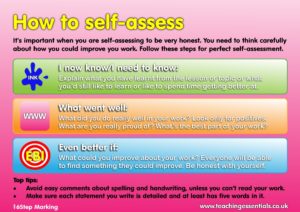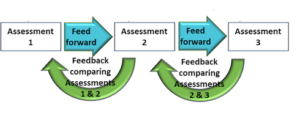Peer and Self-Assessment
 Definition: Peer and self-assessment (PASA) is when students assess each other and themselves against set assessment criteria provided by the teacher and or with their own input in order to evaluate own performance and of their peers. Through this, students can learn from previous mistakes, identify strengths and weaknesses and learn to target their learning accordingly.
Definition: Peer and self-assessment (PASA) is when students assess each other and themselves against set assessment criteria provided by the teacher and or with their own input in order to evaluate own performance and of their peers. Through this, students can learn from previous mistakes, identify strengths and weaknesses and learn to target their learning accordingly.
Description:PASA can be used either formatively or summatively, or both. Use as formative assessment is more common. However, even when not used directly in summative assessment, peer and self-assessment can inform summative marking. Getting students actively involved in their assessment can make the assessment process a means to learn and develop. Assessment criteria must be clearly and fully described so students understand exactly what is expected of them. Allowing students to contribute to the assessment criteria can transfer ownership to them, fostering deeper engagement with assessment and learning. Self-assessment helps students become self-regulated learners.
Benefits:PASA can encourage students to take greater responsibility for their learning, for example, by encouraging engagement with assessment criteria and reflection of their own performance and that of their peers. This can help to change students’ perception of learning as being a passive process to an engaging and self-constructing process. If students are participants rather than receivers they are more likely to engage with their learning. PASA can increase motivation and engagement encouraging students to learn more deeply, building up their understanding, not just their knowledge of facts. They also gain insight into their own approach to an assessment task in comparison to their peers and set criteria. This makes peer and self-assessment an important component of Assessment for Learning rather than just a means of measuring performance. Peer and Self-assessment can support students to develop judgement skills, critiquing abilities and self- awareness.
Challenges: The validity and reliability of students having responsibility for awarding summative grades to their peers has been a concern. Self-assessment does not come naturally to many but can be taught. Teacher feedback and self-assessment are related activities. Using rubrics is a helpful strategy.
Applied to entrepreneurial education:PASA can be effective in supporting the development of generic or transversal skills. The ADEPTT rubric1 (and adaptions) is an example of a self- assessment rubric used for students of different ages (pg. 14) The assessment rubric provides a number of descriptions of achievement for the different learning outcomes; these are not meant to be judgemental but a measure of participants’ confidence to generate novel ideas.
Reference: 1. Moss, C.M., & Brookhart, S.M. (2009) Advancing Formative Assessment in Every Classroom: A Guide for Instructional Leaders. Alexandria, VA: ASCD. 2. University of Reading. (N.d.). Peer and self-assessment. Engage in Assessment. Retrieved from https://www.reading.ac.uk/engageinassessment/peer-and-self-assessment/eia-peer-and-self-assessment-main.aspx 3. Black, P., Harrison, C., Lee, C., Marshall, B., & William, D. (2003). Assesment for learning: Putting it into practice. Maidenhead: Open University Press
1 ADEPTT report https://teachingessentials.wordpress.com/page/2/
 Definition: An ipsative assessment compares a learner’s current performance with previous performance either in the same field through time or in comparison with other fields, resulting in a descriptor expressed in terms of their ‘personal best’.1
Definition: An ipsative assessment compares a learner’s current performance with previous performance either in the same field through time or in comparison with other fields, resulting in a descriptor expressed in terms of their ‘personal best’.1